Developing regulation of energy efficiency of private sector housing (REEPS): modelling improvements to the target stock - Main Research Report
This report describes how the least energy efficient dwellings in the private sector were identified and how their ratings could be improved by a range of improvement measures. Modelling was used to ascertain the least cost way of reaching different standards, with findings presented on capital costs, fuel cost savings, carbon and energy reductions.
9 Appendix 3: Costing Improvement Measures
9.1 An element of the research was concerned with identifying the source and credibility of the costings of improvement measures quoted within RdSAP, and to explore their relationship with real world costings in Scotland.
9.2 The starting point for compiling a list of costs for the various improvement measures to be modelled against the 355 base case archetypes was the Product Characteristics Database File (PCDF). This PCDF is built into SAP and RdSAP software, and contains the costs that appear on EPCs and in Green Deal Advice Reports. Notionally, these costs are updated annually.
9.3 The PCDF does not contain a single cost per improvement measure but a range of costs (see Table A3.1). For most improvement measures, there is a low and a high cost figure given (see the Low Cost Range A and High Cost Range A columns in Table A3.1). There is one measure `with costs in the Low Cost B and High Cost B columns (i.e. New or replacement storage heaters). There are two improvement measures with only a single price in the Low Cost B column (i.e. low energy lighting and insulated doors). The difference between the A Columns and B columns is that the A column represents the cost per job; the B Columns represent a variable cost where the number of units to be installed in the dwelling is multiplied by this variable cost to get the total cost of that improvement measure.
9.4 Where an EPC recommends, for example, a 80mm hot water cylinder jacket, the cost of this improvement would appear as an indicative cost of between £15 and £30, with the low and high cost Column A figures representing lower and upper limits of the indicative cost range presented on the EPC (see Figure A3.1a). For storage heaters, the low and high cost Column B figures would be multiplied by the number of storage heaters to be installed, which in this dwelling was assessed to be 3, to produce an indicative cost range of between £900 and £1200 (see Figure A3.1a). Low energy lights improvement costs would appear as a single figure on the EPC. Figure A3.1b below shows the EPC costs for a dwelling that had 5 light fittings without low energy lamps (see Figure A3.1b).
Figure A3.1a: EPC Indicative range costs

Figure A3.1b: EPC indicative range costs and single figure costs

Table A3.1: Improvement Measure costs within the PCDF
| Improvement Measure | Low cost range A | Low cost B | High cost range A | High cost B | Mean cost |
|---|---|---|---|---|---|
| Loft insulation | 100 | 350 | 225[80] | ||
| Cavity wall insulation | 500 | 1,500 | 1,000 | ||
| Hot water cylinder insulation | 15 | 30 | 22.5 | ||
| Draught proofing | 80 | 120 | 100 | ||
| Low energy lights | 5 | 5 | |||
| Cylinder thermostat | 200 | 400 | 300 | ||
| Heating controls for wet central heating system | 350 | 450 | 400 | ||
| Heating controls for warm air system | 350 | 450 | 400 | ||
| Upgrade boiler, same fuel | 2,200 | 3,000 | 2,600 | ||
| Biomass boiler | 7,000 | 13,000 | 10,000 | ||
| Biomass room heater with radiators | 7,000 | 13,000 | 10,000 | ||
| New or replacement storage heaters | 300 | 400 | 350 | ||
| Replacement warm-air unit | 1,250 | 2,500 | 1,875 | ||
| Solar water heating | 4,000 | 6,000 | 5,000 | ||
| Double glazing | 3,300 | 6,500 | 4,900 | ||
| Secondary glazing | 1,000 | 1,500 | 1,250 | ||
| Solid wall insulation | 4,000 | 14,000 | 9,000 | ||
| Condensing oil boiler | 3,000 | 7,000 | 5,000 | ||
| Change heating to condensing gas boiler | 3,000 | 7,000 | 5,000 | ||
| Photovoltaics | 9,000 | 14,000 | 11,500 | ||
| Wind turbine on roof | 1,500 | 4,000 | 2,750 | ||
| Flat roof insulation | 850 | 1,500 | 1,175 | ||
| Roof room insulation | 1,500 | 2,700 | 2,100 | ||
| Flue gas heat recovery | 900 | 450 | |||
| Floor insulation | 800 | 1,200 | 1,000 | ||
| Insulated doors | 500 | 500 | |||
| Waste water heat recovery | 585 | 725 | 655 | ||
| Biomass boiler | 7,000 | 13,000 | 10,000 | ||
| Solid wall insulation and cavity wall insulation | 4,500 | 15,500 | 10,000 | ||
| Air Source Heat Pump with radiators | 6,000 | 10,000 | 8,000 | ||
| Air Source Heat Pump with underfloor heating | 6,000 | 10,000 | 8,000 | ||
| Micro combined heat and power (co-generation) | 5,500 | 5,500 | |||
| Ground source heat pump with radiators | 9,000 | 17,000 | 13,000 | ||
| Ground source heat pump with underfloor heating | 9,000 | 17,000 | 13,000 | ||
| Triple glazing | 5,000 | 10,000 | 7,500 | ||
| Wind turbine separate mast | 15,000 | 25,000 | 20,000 |
9.5 The mean cost (i.e. the last column in Table A3.1 above) was calculated as part of the research project and does not appear in the PCDF, nor is it used in SAP and RdSAP assessments.
9.6 An attempt was made by the contractors to track the PCDF insulation cost ranges back to a unit prices per m2 (see the background note on this attempt at the end of this appendix).
9.7 As an additional check on the PCDF improvement costs, other costs were collated for the range of improvement measures from a variety of other sources, including:
- those used in a report by the Parity Projects[81] which was concerned with a similar area of research work in England;
- those obtained through interviewing three Scottish central belt contractors for doing improvement works on a one-off dwelling;
- an attempt to work out costs from scratch using a UK SPONS 2014 pricing guide for preparing tender costs[82] ;
- internet searches for costs for the new high heat retention (i.e. Quantum) electric storage heaters and for replacement heating appliances.
9.8 The collated results are set out in Table A3.2 below. Not all of the prices for all of the improvement options were available from every source.
Table A3.2: Assorted Cost of Improvement Measures
| PCDF mean cost | Parity Project Costs | Contractor1 £/job unless stated | Contractor2 £/job unless stated | Contractor3 £/job unless stated | SPONS exercise £/job unless stated | Web search £/job unless stated | |
|---|---|---|---|---|---|---|---|
| £/job unless stated | £/job unless stated | ||||||
| Loft insulation from 0 to 300mm | £350 (High cost used) | £350 | 5.90/m2 + 2.60/m2 in rural Scotland | £6.50/m2 | £4/m2 | ||
| Loft Insulation top up from 200 to 300mm | £100 (Low cost used | £300 | 3.80/m2 + 2.60/m2 in rural Scotland | £4.5/m2 | 2.74/m2 | ||
| Cavity wall insulation | £1,000 | £300 | 3.60/m2 per 50mm gap + 2.80/m2 in rural Scotland; 5/m2 per 85mm gap + 2.80/m2 in rural Scotland | £5/m2 (Bead) | |||
| Hot water cylinder jacket insulation (80mm) | £22.5 | £40 | £20 | ||||
| Draught proofing | £100 | £50 + (fraction not DP * £150) | £40 + £18 per window unit (sash counts as 2 units); £22 per door | ||||
| Low energy lights | £5 per bulb | £20 per bulb | |||||
| Fit Cylinder thermostat | £300 | £300 | £120 | ||||
| Heating controls for wet central heating system full package | £400 | £500 | £200 for combined room thermostat and programmer | ||||
| Heating controls for wet central heating system part package | £280 | £200 for combined room thermostat and programmer | |||||
| Fit Thermostatic Radiator Valves | £20 per TRV | If system drained £45 for first and £20 for rest. If system not drained £90 for first and £20 for rest | |||||
| Heating controls for warm air system | £400 | ||||||
| Upgrade combi boiler, mains gas | £2,600 | £1,500 | £1,650 | £1,600 | |||
| Upgrade standard boiler, mains gas | £2,400 | £1,650 | £1,850 | ||||
| Biomass boiler | £10,000 | ||||||
| Biomass room heater with boiler | £10,000 | ||||||
| New or replacement storage heaters | £350 per storage heater | £2,500 | |||||
| New or replacement Quantum storage heaters | £700 per heater | ||||||
| Electric wet system (direct / CPSU / thermal store) | £4,000 | ||||||
| Replacement warm-air unit | £1,875 | ||||||
| Solar water heating | £5,000 | £3,500 for 4m2 | £3,560 to £4,500 for 4m2 | ||||
| Double glazing low-e (u-value 2.1) | £4,900 | £250/m2 | £350 per window (upvc) | 120/m2 standard and 270/m2 fully reversible | £162/m2 | ||
| A-rated Double Glazing low-e Argon (u- value 1.8) | £350/m2 | ||||||
| Secondary glazing | £1,250 | £45/m2 | |||||
| Solid wall insulation - internal wall insulation | £9,000 | £55/m2 | £70/m2 modern; £85/m2 older home plus extras (+£5.80/m2 in rural Scotland) | £50/m2 | £120/m2 | £23/m2 | |
| Solid wall insulation - external wall insulation | £9,000 | £90/m2 | £80/m2 plus extras + £5.80/m2 in rural Scotland | 100/m2 | £44/m2 plus scaffold | ||
| Condensing oil boiler and radiators | £5,000 | £5,400 | |||||
| Change heating to condensing gas condensing boiler and radiators | £5,000 | £3,000 | £3,200 | £2,800 | £55 to £77/m2 | ||
| Photovoltaics | £11,500 | £600 + £1,350/kWp | £4,409 to £5,454 per kWp | ||||
| Wind turbine on roof | £2,750 | ||||||
| Flat roof insulation | £1,175 | £50/m2 | |||||
| Roof room insulation | £2,100 | As internal wall insulation | £50/m2 | ||||
| Flue gas heat recovery | £450 | ||||||
| Floor insulation - below suspended timber floor | £1,000 | £400 + £25/m2 | £16/m2 + £2.60/m2 in rural Scotland | ||||
| Floor insulation - above solid floor | £1,000 | £400 + £30/m2 | £30/m2+ £2.60/m2 in rural Scotland | £20/m2 | |||
| Insulated door | £500 per door | £900 per door | £370 per door | ||||
| Waste water heat recovery | £655 | £300 + £350 per room installed | |||||
| Biomass boiler | £10,000 | ||||||
| External wall insulation + cavity fill insulation | £10,000 | ||||||
| Air Source Heat Pump with Radiators | £8,000 | £7,500 | |||||
| Air Source Heat Pump with underfloor heating | £8,000 | ||||||
| Micro co-generation (also known as micro CHP) | £5,500 | ||||||
| Ground Source Heat Pump with radiators | £13,000 | £11,000 | |||||
| Ground Source Heat Pump with underfloor heating | £13,000 | ||||||
| Triple glazing | £7,500 | £370/m2 | £145/m2 standard, £295/m2 fully reversible | ||||
| Replacement LFE inset gas fire flued | £450 | ||||||
| Solid fuel fire cassette | £450 | ||||||
| New Hot Water Cylinder with 50mm Spray Foam | £750 per dwelling | £450 | |||||
| Wind turbine separate mast | £20,000 |
9.9 What emerges from Table A3.2 is that there is no one consistent cost for any of the improvement measures; the costs are not even presented in the same units. There was usually no explanation that accompanies the costs to elaborate on what is included or not included within them. It also became quite clear when interviewing the contractors that the costs of doing jobs in the Highlands and Islands and other rural areas would be higher still.
9.10 Among the three contractors there was a consensus that the cost of solid wall insulation, whether internally or externally applied, was determined 'by the details' - that is, how you deal with reveals around windows, the fitting of new sills, the treatment of satellite and telecommunication systems affixed to walls, the treatment of external gas and electricity meters, the treatment of existing vents, the external finish of the system, and the level of decoration to be done subsequently by the contractor. One contractor stated that if you included for everything in a single price then you would never win a contract. These things were usually identified as specified extras to the quoted per m2 price.
9.11 One contractor specifically quantified some of these costs for working in the Highlands and Border areas of Scotland (which was deemed to be more than 1 hour drive time up to about 0.5 day drive from the central belt of Scotland), as they were working on contracts in those areas at the time of the interview. Additional rural costs ranged from a further 7%-8% for solid wall insulation; 9%-16% for floor insulation; 44% for loft insulation (and 68% for top up loft insulation); 56% or 78% for cavity wall insulation, depending on the gap to be filled. Working on the islands would be more again as ferry costs would also have to be then factored in.
9.12 Using the dimensional data from the 355 archetypes, the costs for various insulation improvements were calculated using the different contractor unit prices set out in Table A3.2 above. The distribution of the calculated job costs could then be compared with the indicative costs from the PCDF.
Loft Insulation Costs
9.13 In Figures A3.2 and A3.3, the range of costs for top up loft insulation (i.e. where there is some loft insulation already) and virgin loft insulation (i.e. where there is no loft insulation at all) are presented. For top-up loft insulation the calculated contractor costs ranged between £53 and £1598, while the virgin loft insulation costs ranged between £83 and £2120 (see Table A3.3).
Table A3.3: Loft Insulation Costs
| Top-up loft insulation | Virgin loft insulation | |
|---|---|---|
| Number of instances (n) | 624 | 624 |
| Number > £350 | 181 | 358 |
| Number <£100 | 6 | 2 |
| % outside PCDF range | 30% | 58% |
| Mean cost | £306 | £439 |
| Median cost | £266 | £384 |
| Maximum cost | £1,598 | £2,130 |
| Minimum cost | £53 | £83 |
| Cost used in modelling | £350 | £350 |
| % difference between mean contractor and cost used in modelling | -12% | 25% |
Figure A3.2: Range of top-up loft insulation costs calculated from 355 archetypes data
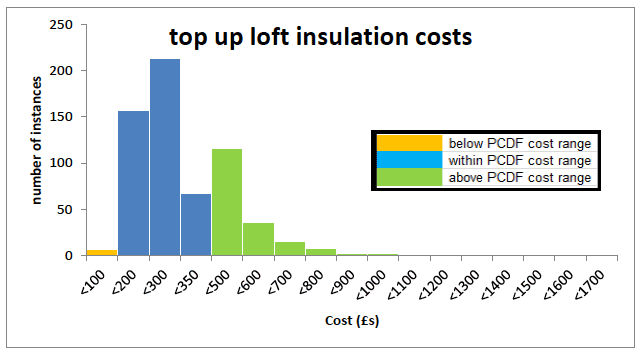
Figure A3.3: Range of virgin loft insulation costs calculated from 355 archetypes data
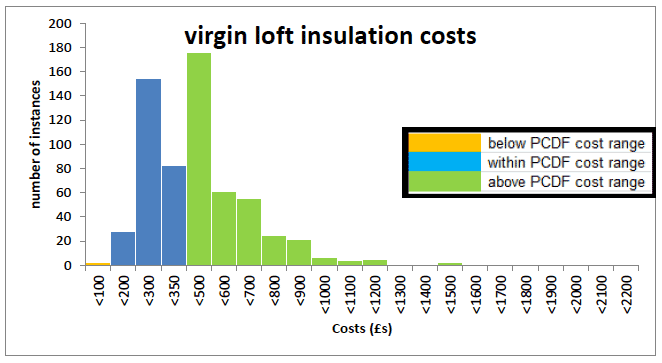
9.14 For the top-up loft insulation, the majority of costs fall within the PCDF range of £100 to £350, which is not the case with the virgin loft insulation costs, where the majority fall outside the PCDF range, with most being higher than the PCDF range. This situation is repeated with the mean and median costs for the two measures, with the top up mean and median costs falling within the PCDF range and the virgin loft costs being higher. Compared to the costs used in the modelling, mean contractor costs were 12% lower for top-up insulation and 25% higher for virgin loft insulation.
Flat Roof Insulation Costs
9.15 In Figure A3.4, the range of costs for flat roof loft insulation is presented. There are considerably fewer instances of flat roofs amongst the 355 archetypes than pitched roofs. For flat roof insulation the calculated contractor costs ranged between £200 and £5300 (see Table A3.4).
| Flat roof insulation | |
|---|---|
| Number of instances (n) | 49 |
| Number > £1500 | 14 |
| Number <£850 | 20 |
| % outside PCDF range | 68% |
| Mean cost | £1,310 |
| Median cost | £950 |
| Maximum cost | £5,300 |
| Minimum cost | £200 |
| Cost used in modelling | £1,175 |
| % difference between mean contractor and cost used in modelling | 12% |
Figure A3.4: Range of flat roof insulation costs calculated from 355 archetypes data
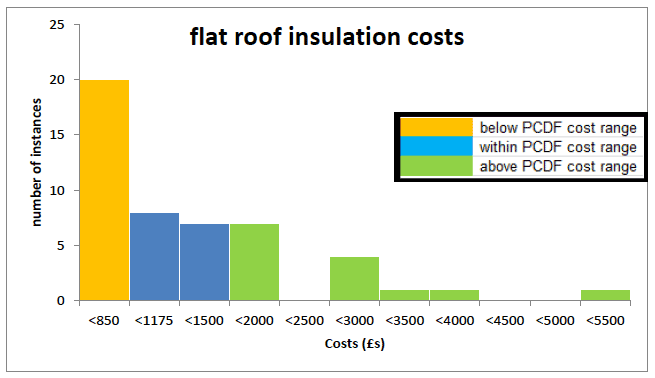
9.16 For the flat roof insulation, the majority of costs fall outside the PCDF range of £850 to £1500, with the largest number coming in lower than the PCDF range. This probably reflects that many of the instances of flat roofs within this data set were on small extensions rather than the main dwelling. The mean and median figures for flat roof insulation fall within the PCDF range. Compared to the costs used in the modelling, mean contractor costs were 12% higher.
Cavity Wall Insulation Costs
9.17 In Figure A3.5, the range of costs for cavity wall insulation is presented, with the calculated contractor costs ranging between £47 and £1215 (see Table A3.5).
Table A3.5: Cavity Wall Insulation Costs
| Cavity wall insulation | |
|---|---|
| Number of instances (n) | 296 |
| Number > £1500 | 0 |
| Number <£500 | 241 |
| % outside PCDF range | 81% |
| Mean cost | £323 |
| Median cost | £295 |
| Maximum cost | £1,215 |
| Minimum cost | £47 |
| Cost used in modelling | £1,000 |
| % difference between mean contractor and cost used in modelling | -68% |
Figure A3.5: Range of cavity wall insulation costs calculated from 355 archetypes data
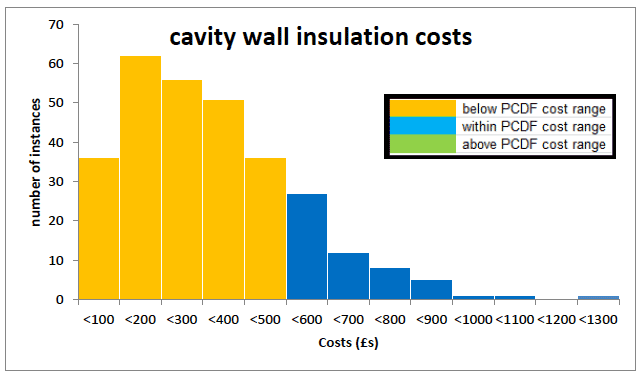
9.18 For the cavity wall insulation, the majority of costs fall outside the PCDF range of £500 to £1500. None of the calculated costs were greater that the PCDF higher limit, but 81% were lower than the PCDF lower limit. The mean and median figures for cavity wall insulation fell below the PCDF range. Compared to the costs used in the modelling, mean contractor costs were 68% lower.
Internal Wall Insulation
9.19 In Figure A3.6, the range of costs for internal insulation is presented, with the calculated contractor costs ranging between £950 and £40,200 (see Table A3.6).
Table A3.6: Internal Wall Insulation Costs
| Internal wall insulation | |
|---|---|
| Number of instances (n) | 675 |
| Number > £14,000 | 81 |
| Number <£4,000 | 155 |
| % outside PCDF range | 35% |
| Mean cost | £7,977 |
| Median cost | £6,370 |
| Maximum cost | £40,200 |
| Minimum cost | £950 |
| Cost used in modelling | £9,000 |
| % difference between mean contractor and cost used in modelling | -11% |
Figure A3.6: Range of internal wall insulation costs calculated from 355 archetypes data
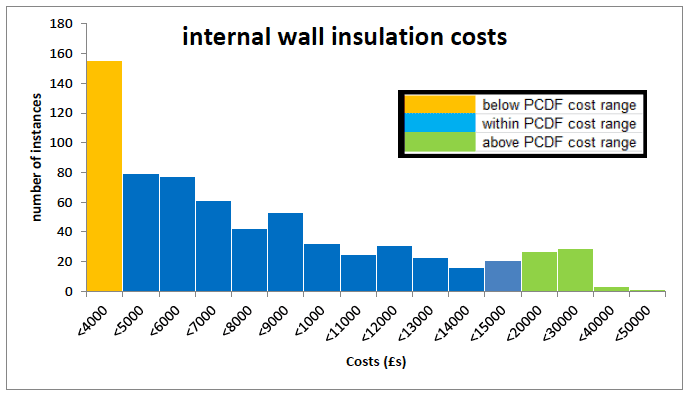
9.20 For the internal wall insulation, despite some very high costs, the majority of costs fall within the PCDF range of £4,000 to £14,000, as did both the mean and median figures for internal wall insulation. Compared to the costs used in the modelling, mean contractor costs were 68% lower.
External Wall Insulation Costs
9.21 In Figure A3.7, the range of costs for external insulation is presented, with the calculated contractor costs ranging between £1520 and £33,500 (see Table A3.7).
Table A3.7: External Wall Insulation Costs
| External wall insulation | |
|---|---|
| Number of instances (n) | 450 |
| Number > £14,000 | 61 |
| Number <£4,000 | 59 |
| % outside PCDF range | 27% |
| Mean cost | £8,974 |
| Median cost | £8,000 |
| Maximum cost | £33,500 |
| Minimum cost | £1,520 |
| Cost used in modelling | £9000 |
| % difference between mean contractor and cost used in modelling | 0% |
Figure A3.7: Range of external wall insulation costs calculated from 355 archetypes data
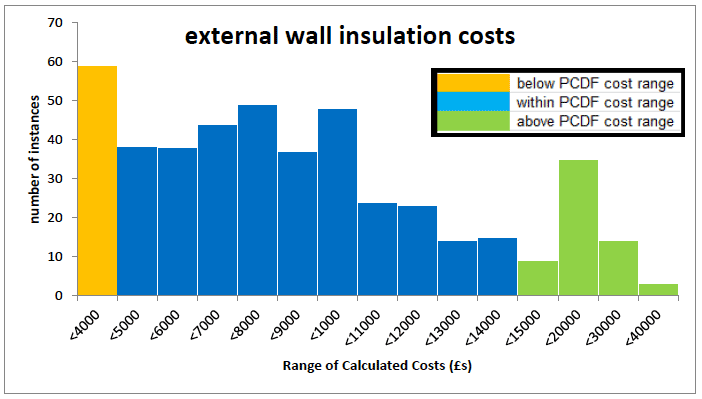
9.22 As with the internal wall insulation costs, the majority of the external wall insulation costs, despite some very high costs, fall within the PCDF range of £4,000 to £14,000 (73%), as did both the mean and median figures for internal wall insulation. Compared to the costs used in the modelling, mean contractor costs were identical.
Room in the Roof Insulation
9.23 In Figure A3.8, the range of costs for room in the roof insulation is presented, with the calculated contractor costs ranging between £1556 and £7159 (see Table A3.8).
Table A3.8: Room In the Roof Insulation Costs
| Room in the Roof insulation | |
|---|---|
| Number of instances (n) | 348 |
| Number > £14,000 | 288 |
| Number <£4,000 | 0 |
| % outside PCDF range | 83% |
| Mean cost | £3697 |
| Median cost | £3552 |
| Maximum cost | £7159 |
| Minimum cost | £1556 |
| Cost used in modelling | £2,100 |
| % difference between mean contractor and cost used in modelling | 76% |
Figure A3.8: Range of room in the roof insulation costs calculated from 355 archetypes data
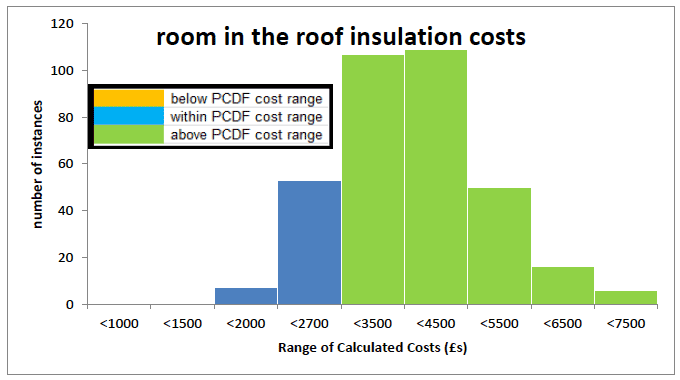
9.24 For the room in the roof insulation, the majority of costs fall outside the PCDF range of £1500 to £2700. None of the calculated costs were lower than the PCDF lower limit of £1500, but 83% were higher than the PCDF higher limit. The mean and median figures for room in the roof insulation were both higher than the PCDF range. Compared to the costs used in the modelling, mean contractor costs were 76% higher.
Floor Insulation Costs
9.25 In Figures A3.9 and A3.10, the range of costs for suspended timber floor insulation (i.e. where there is some void space beneath the floor that can be insulated) and solid floor insulation (i.e. the insulation has to be laid on top of the existing floor) are presented. For the suspended timber floor insulation the calculated contractor costs ranged between £96 and £5680, while the solid floor insulation costs ranged between £104 and £4200 (see Table A3.9).
Table A3.9: Floor Insulation Costs
| Suspended timber floor insulation | Solid floor insulation | |
|---|---|---|
| Number of instances (n) | 226 | 166 |
| Number > £1200 | 113 | 100 |
| Number <£800 | 63 | 54 |
| % outside PCDF range | 79% | 93% |
| Mean cost | £1221 | £1405 |
| Median cost | £1096 | £1407 |
| Maximum cost | £5680 | £4200 |
| Minimum cost | £96 | £104 |
| Cost used in modelling | £1,000 | £1,000 |
| % difference between mean contractor and cost used in modelling | 22% | 41% |
Figure A3.9: Range of suspended timber floor insulation costs calculated from 355 archetypes data
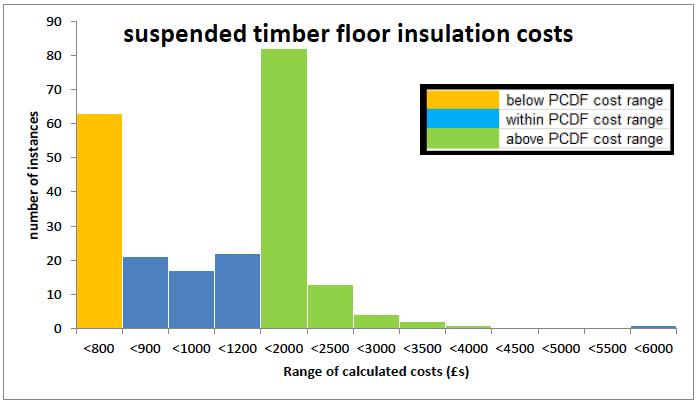
Figure A3.10: Range of suspended solid floor insulation costs calculated from 355 archetypes data
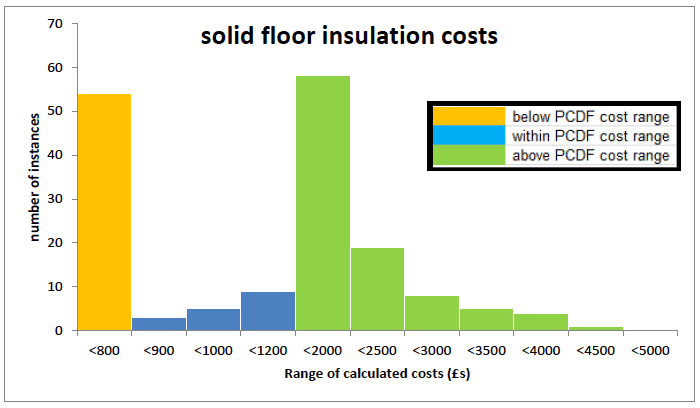
9.26 For the floor insulation costs, the majority of costs for both suspended timber floor and solid floor insulation fall outside the PCDF range of £800 to £1200, but the mean and median costs are either within the PCDF range or just above it. Solid floor insulation is slightly more expensive than the suspended timber floor insulation. Compared to the costs used in the modelling, mean contractor costs were 22% higher for suspended timber and 41% higher for solid floor insulation.
Comment on the Calculated Costs Exercise
9.27 What emerges from this exercise is the wide variability in prices when they are costed on a square metre basis. Further, there is no consistent bias one way or the other when these calculated costs are compared are against the PCDF range of cost.
9.28 The calculated contractor costs for cavity wall insulation were generally much less than the PCDF range. By contrast; the calculated costs for floor insulation, room in the roof insulation and virgin loft insulation were generally higher than the PCDF range. Solid wall insulation, external wall insulation and top up loft insulation were generally within the PCDF range. However, even when the majority of prices were outside the PCDF price range for a measure, the mean and median values were still generally within the PCDF range or close to it.
9.29 For other measures where costs are directly comparable, contractor costs were substantially lower for (i) fitting cylinder thermostat, (ii) upgrading combi boiler- mains gas, (iii) solar water heating.
Comments on Other Cost Comparisons
9.30 There was also a mixed picture in comparisons of PCDF mean costs with those used in the Parity Project, where a direct comparison could be made. In particular, the Parity Project costs were substantially higher for hot water cylinder jacket insulation, low energy lights and insulated doors. They were considerably lower for cavity wall insulation, upgrading mains gas combi boilers, converting to condensing gas boilers and radiators, solar water heating and ground source heat pumps with radiators. Costs were similar for loft insulation and fitting a cylinder thermostat.
9.31 Direct comparisons with most of the SPONS costs provided could not be made with mean PCDF costs, due to the use of different cost units.
The background and basis of PCDF costs
9.32 In 2011, with the extension of the range of measures when RdSAP 2009 v9.91 was launched, the EST provided Communities and Local Government (CLG - a department of the UK Government) with updated improvement costs for use in the Energy Performance Certificates (EPCs). The array of cost ranges for the various energy efficiency measures was intended to provide a broad range of indicative costs according to the available data at that time.
9.33 For example, the solid wall insulation cost range of between £4000 and £14,000 was derived from research the EST commissioned on the Solid Wall Insulation Supply Chain conducted by Purple Market Research Group. The range represented the lower cost estimation for internal solid wall insulation and the upper cost for the cost of external solid wall insulation. When the EST reviewed the data they found it corroborated the estimates from DECC Impact Assessments (IA) from DECC's Climate and Energy Science Advisory Team (CESA), therefore it was agreed to use the CESA range.
9.34 All the published figures supplied were intended as indicative ranges to encompass the majority of household types and circumstances, to give an indicative estimation of the range of costs householders could expect. With a lot of energy efficiency measures, it was recognised that costs are highly variable and influenced by property circumstances such as construction type, installation methods, location, thickness, material etc.
9.35 BRE staff responsible for overseeing SAP and RdSAP confirmed the price ranges in the PCDF come from the EST.
9.36 While the fuel prices quoted on the EPC change on a 6-monthly basis, the improvement costs seem to be still those from the original implementation of RdSAP in 2012. It would appear that the EST themselves do not use the PCDF improvement costs. On the EST website, they note they "have updated our costs and the new costs ranges can be found on our website at: http://www.energysavingtrust.org.uk/Insulation"
9.37 On this website there are different costs quoted, sometimes for specific dwelling types, sometimes ballpark ranges, and sometimes not at all, which are summarised in Table A3.10. From this table, the quoted loft insulation costs are generally within the PCDF range, though the virgin loft insulation cost for the detached dwelling exceeds the PCDF range. The cavity wall insulation costs are considerably lower than the PCDF range, and in keeping with the calculated cost for cavity wall insulation calculated using the contractor data in para 9.17-9.18 above. The quoted range of internal and external wall insulation costs are greater than those quoted in the PCDF, as are the solid floor insulation costs. The suspended timber floor costs are lower than the PCDF range.
Table A3.10: EST Web-site Insulation Costs
| Detached house | Semi-detached | Mid terrace | Detached bungalow | Flat | |
|---|---|---|---|---|---|
| Loft insulation 0mm to 270mm | £395 | £300 | £285 | £265 | nq |
| Loft insulation top up 100mm to 270mm | £265 | £220 | £215 | £205 | nq |
| Cavity wall insulation | £720 | £475 | £370 | £430 | £330 |
| External wall insulation | £9,000 to £26,000 | ||||
| Internal wall insulation | £4,000 to £16,000 | ||||
| Solid floor insulation | £900 to £2400 | ||||
| Suspended timber floor insulation | £300 to £700 | ||||
| Draughtproofing | £100 DIY, “double that if professionally installed” | ||||
| Glazing | No costs quoted | ||||
9.38 The EST stated that, "All our costs by different house types published on our website are based on BRE Standard Dwelling Dimension, information on the characteristics of the house types can be found on our assumption pages: http://www.energysavingtrust.org.uk/Energy-Saving-Trust/Our-calculations"
9.39 This summary of assumptions is produced in Table A3.11.
Table A3.11: EST Assumptions Used in Calculating Insulation Costs
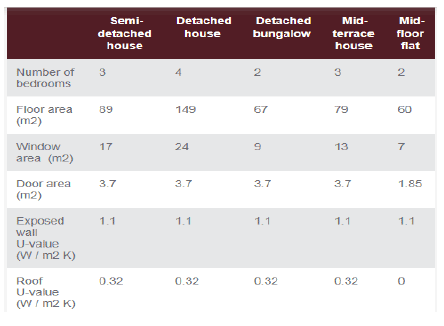
9.40 An BRE document entitled 'Standard Dwellings for Energy Modelling' was originally produced in 1999, and updated in 2012, which includes a number of different dwelling types, along with their respective floor plans, elevations and dimensions. From the EST dwelling data above, the semi-detached house above appears to be consistent with the large semi-detached house (1945-64) in the BRE document; the detached dwelling above consistent with the large detached house (1965-80) in the BRE document; the detached bungalow above consistent with the detached bungalow (post 1990) in the BRE document; the mid terrace house above consistent with the modern mid-terrace house (1990-2001) in the BRE document; and the mid floor flat above consistent with the 2-bedroom flat (1945-1964) in the BRE document.
Table A3.12: BRE Standard Dwelling Dimensional Data
| Detached house | Semi-detached house | Mid terrace house | Detached bungalow | Flat | |
|---|---|---|---|---|---|
| Loft insulation area | 74.25m2 | 44.37 m2 | 39.44 m2 | 67.32 m2 | 60.94 m2 [83] |
| Gross external wall area | 199.7 m2 | 102.5 m2 | 92 m2 | 80.16 m2 | 37.68 m2 [84] |
| Heat Loss floor area | 74.2 m2 | 44.37 m2 | 39.44 m2 | 67.32 m2 | 60.94 m2 [85] |
9.41 Combining this BRE dimensional data and the costs from the EST website allows a basic cost per m2 for each insulation measure to be calculated (see Table A3.13).
Table A3.13: Derived m2 Insulation costs
| Detached house | Semi-detached | Mid terrace | Detached bungalow | Flat | |
|---|---|---|---|---|---|
| Loft insulation 0mm to 270mm | £5.32 | £6.76 | £7.23 | £3.94 | nq |
| Loft insulation top up 100mm to 270mm | £3.57 | £4.95 | £5.45 | £3.05 | nq |
| Cavity wall insulation | £3.61 | £4.63 | £4.02 | £5.36 | £8.76 |
| Solid floor insulation | £12.12 - 32.32 | £20.28 - £54.09 | £22.82 - £60.85 | £13.37 - £35.65 | nq |
| Suspended timber floor insulation | £4.04 - £9.43 | £6.76 - £15.78 | £7.61 - £17.75 | £4.46 - £10.40 | nq |
| External wall insulation | £45.07 - £130.19 | £87.80 - £253.66 | £97.83 - £282.61 | £112.28 - £324.35 | £238.85 - £690.02 |
| Internal wall insulation | £20.03 - £130.19 | £39.02 - £156.10 | £43.48 - £173.91 | £49.90 - £199.60 | £106.16 - £424.63 |
9.42 What emerges from the EST data is that again there are a wide range of costs, and no consistency, across the different dwelling types for the different insulation measures.
Overall comment
9.43 As already noted above, the PCDF improvement cost figures were intended to provide an indicative range of cost for different energy efficiency measures within the energy advice report of the EPC, covering the broad majority of household types and circumstances, so as to provide the householder with an estimation of the range of costs they could expect. It was recognised that the costs are highly variable for a wide range of reasons. Just how variable the improvement costs can be was only further emphasised by the calculated cost exercise carried out using the archetype dimensional data and the unit prices obtained from three Scottish contractors. Yet, despite the high degree of variability within the calculated costs of the different insulation measures examined, many of the mean and median costs fell within the PCDF range of costs for the respective measure. Comparisons of mean contractor costs with those used in the modelling did however show large differences, both higher and lower, for some of the insulation measures.
9.44 The REEPS RAG took the decision to use the Product Characteristics Database File (PCDF) costs for improvement measures, in the absence of a robust, comprehensive, nationally recognised, evidence based, alternative. RAG was not willing to base the research modelling on prices quoted by a small number of contractors. RAG was also mindful of ensuring research results were consistent with EPC reports, which are based on PCDF costs.
9.45 In addition, RAG took the decision to use mean PCDF costs, as corresponding unit costs were not available. It was recognised by RAG that this will lead to some over/under estimation of costs for individual archetypes, depending on their size and other characteristics. However, the use of mean costs would result in the best central estimates for the aggregated results.
Contact
Email: Silvia Palombi
There is a problem
Thanks for your feedback